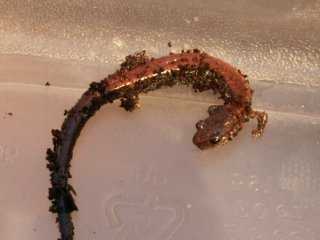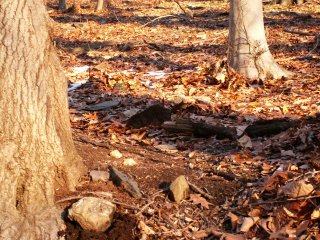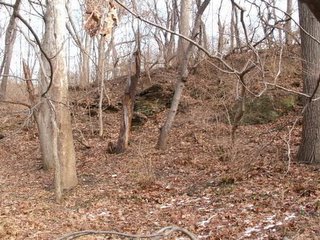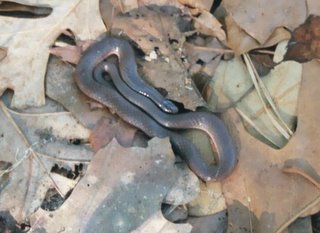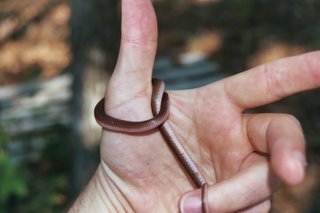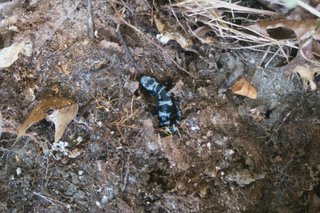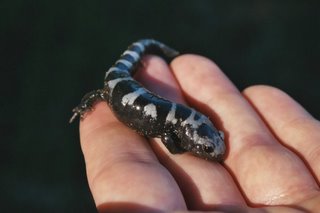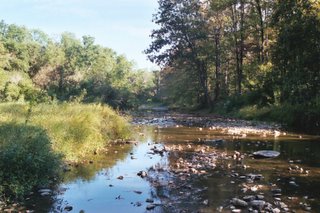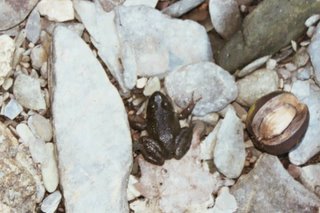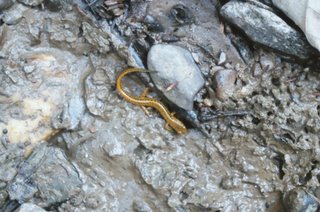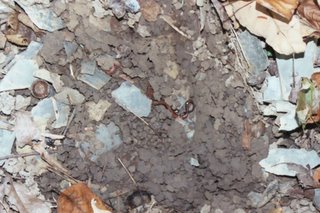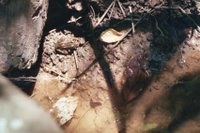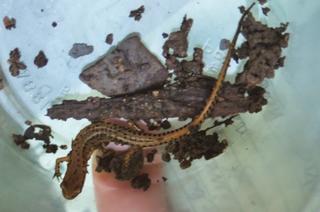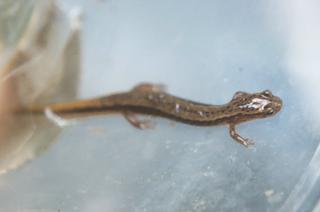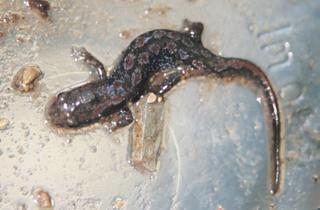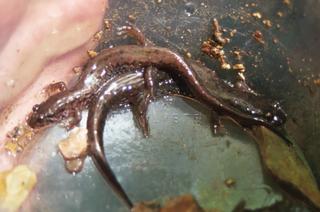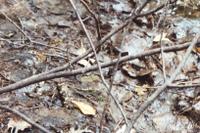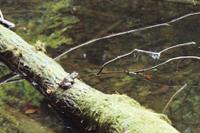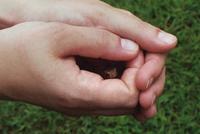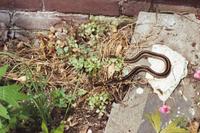I was back in Roswell Georgia at the in-laws’, eating very well and taking part in the festivities. For Christmas I got Whit Gibbons’ Their Blood Runs Cold to add to my herping literature collection as well as some nice topographical maps for PA State Game Lands 106 and 110. I’m not getting lost again out there. I also got money, some of which I quickly spent on The Herpetology of China, by Kraig Adler Zhao, and a gift card to Barnes and Noble, which I exchanged towards Henry Fitch’s A Kansas Snake Community: Composition and Changes Over 50 Years, a classic work on herpetological ecology. Wow, all this really could give someone the impression that I’m obsessed.
Anyhow, I popped outside on Christmas to check out the ravine behind the house. The ravine is densely wooded and cut by a couple small brooks running down to a pond at the bottom.

It is home to a surprisingly large variety of herps, including American toads (Bufo a. americanus), southern two-lined salamanders (Eurycea cirrigera), midland brown snakes (Storeria dekayi wrightorum), southern black racers (Coluber constrictor priapus), eastern box turtles (Terrepene carolina carolina), and northern ringneck snakes (Diadophis punctatus edwardsii). The housing subdivision is relatively new (built in the last ten years or so), so I’m not optimistic about the future herp diversity there, but for the time being it’s worth poking around.
I worked the rocky sections of the two brooks.

I say ‘rocky sections’ because the two brooks are heavily silted by runoff from the pavement and lawns above – one reason for the pessimism I mentioned above.
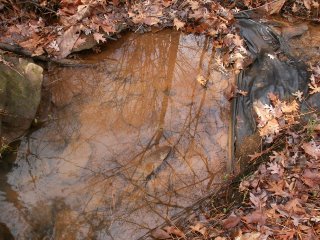
I was nearly finished and figuring my winter salamandering luck hadn’t flown south with me when I checked out a rock at the start of my last section of un-silted rocks. I saw a stocky, dark salamander dart out. I reached for it, but it made it into a clump of leaves, and I think from there into a crevice or hole in the bank since I had no luck sifting through the leaves. By the size, shape, and where I found it, I am pretty sure it was some kind of dusky salamander (Desmognathus species).
The day after Christmas I went for my run at the park I mentioned in my post on November 22, 2005. I decided not to bring my camera. This was a hard decision. It’s a pain in the butt to carry my camera while running, but I’m superstitious enough to believe that not carrying it will guarantee seeing something I’ll want to photograph, in the same sense that forgetting your umbrella makes it rain.
I love the running back there. After about a half mile warm up out of the subdivision and through the Super Target strip mall parking lot, the 2.25 mile trail is a lot of fun, twisty, up and down running. I stopped twice to look for herps.
The first stop was at what looked like a vernal pool in at a low-lying spot in the woods. I wondered if I might poke around for amphibians at the edge of the water, but I sank into the mud before I got very close. I don’t like running in water-logged sneakers, so I turned back, and tried one soggy log before getting back to the trail.
Sure enough, there was a frog under that log – a small (one inch) green frog (Rana clamitans melanota). It was so cool and so calm. I felt kind of sorry for it. They must be so helpless when raccoons or foxes find them like that. I put it down next to its soggy log and ran for another mile and a half. Towards the end of the loop the path runs across and then along a small stream. I had meant to finish the trail and run straight back to the house. Wasn’t one find enough for incidental herping?
No, not when the stream was right there. I just hopped the bank, and there I was with perfect rocks all around me. I peeked under no more than four or five before I found a small (about 1.25”) dark salamander. It hid in some leaves at the bottom, and I gently scooped up the leaves in my hands to take a closer look at it. It had a dark brown back and no pattern. I was sure it was a young dusky, but these can be tricky to tell apart, so I was looking for any clues that could help. I checked its belly and saw right through to its internal organs, a scene dominated by a red blob that I think was the liver. It had a sharply keeled tail, but that’s all I could tell right there and then. I let it go next to its rock, and kept moving up.
I jumped up to another stretch of the stream and soon found something even more exciting: a group of smaller (.75”) larvae clustered together under a rock. This rock was not immersed, but rather lay at a 45 degree angle with a sheet of water trickling beneath it along the sandy bed. The little guys scattered. There was a small pool beneath in which I spotted a crayfish as I tried to fish out one of the little guys. I finally got one in hand and checked the back. This time I did see a pattern. I made out four pale spots on each side of its back on a dark brown background.
It was somehow poetically correct to find a big adult a few feet away. I turned over the rock and saw a salamander head retract into a hole. I dug my hand into the sand about six inches behind, and scooped up a five inch dusky. But what kind of dusky was it? I can never remember everything I should be looking for (and believe me, it gets really detailed, like whether the bottom of the base of the tail is wider than it is tall, how sinuous the line of the mouth is, how many costal grooves), so I checked what I could remember: the pattern and the keel on the tail.
Its back was a solid dark brown – no pattern I could make out except just above the belly on each side where there were rows of pin-point white dots. I checked the belly and found heavy dark gray mottling. The tail was sharply keeled with the keel starting about one-third down.
Back at the house I checked my herping bible, Reptiles and Amphibians, Eastern/Central North America by Conant and Collins. By range I narrowed it down to three desmognathus species: the seal salamander (D. monticola), the spotted dusky (D. fuscus conantii, or the mountain dusky (D. achrophaeus). The mountain dusky has a round tail, so that one was out. I had a hard time between the other two, and I could be wrong here, but I went with the pattern on that one larvae as the kicker. Mountain dusky larvae have their spots laid out in a zig zag along a lighter center stripe, while seal larvae have their spots in neat, symmetrical rows of four and a dark background, which was exactly what I had found. The pictures of seal salamanders in my books have bold squiggly patterns on light backgrounds, but my Conant and Collins do confirm that at the southern end of the range they tend to have fainter patterns and that older adults can be dark, solid, purple/brown and have white bellies mottled with gray and brown. James Petranka’s Salamanders of the United States and Canada mentions the keel starting one-third of the way down the tail of the seal salamander as well, making me surer of the identification.
Totals for December 25-26, 2005:
- 1 mystery dusky salamander
- 6 seal salamanders
- 1 green frog
This weekend I mean to herp in the New Year, this time back in the tri-state area.
Here are a couple more discoveries:
Someone just turned me on to the Center for North American Herpetology’s publications page, which has tons of great PDFs of journal articles for free downloading. This is a great resource for herp enthusiasts like me are out of school and miss the easy access to journal articles. I’ve added the CNAH’s website to the links to the right.
I also just discovered an organization called PARC, a public/private partnership that promotes herpetological conservation best practices by governments as well as by private individuals. I’ve added a link to their site as well.
Happy holidays, and have a Herpy New Year!

